Technologies
Galaxy A54 5G Review: Samsung’s Cheap Phone Struggles Against Google
It’s cheap and offers decent performance, but Samsung’s A54 5G doesn’t quite measure up to the Pixel 6A.


Samsung Galaxy A54 5G
Like
- Big, vibrant screen
- Expandable storage
- Affordable price
Don’t like
- Processor and camera performance lags behind cheaper Pixel 6A
Samsung’s flagship Galaxy S23 Ultra packs some of the most potent specs and powerful cameras around. But it also comes with a whopping price $1,200 (£1,249, AU$1,949) tag that’s simply out of the question for many of us. Looking lower down the range doesn’t mean suffering with slow, frustrating hardware. As Samsung’s new $450 (£499, AU$699) Galaxy A54 5G proves, you can get a phone with solid performance for a very reasonable price.
The Galaxy A54 packs a 6.4-inch display, an octa-core processor that offers enough power for daily essentials (including light gaming) and a camera that does a decent job of handling your out-and-about snaps. I even like the design, particularly the lime green version I reviewed. Its 128GB of storage will be enough for most people, and those who need more space can expand it with microSD cards up to 1TB in size.
Advertiser Disclosure
It’s got a lot going for it considering its reasonable $450 price tag, but it’s often on sale for even less, with prices of $375 seen on Best Buy and Amazon during my writing of this review, although sadly not at the point of publishing. Even with that potential discount, Google’s budget phones outshine Samsung in key areas — particularly the camera.
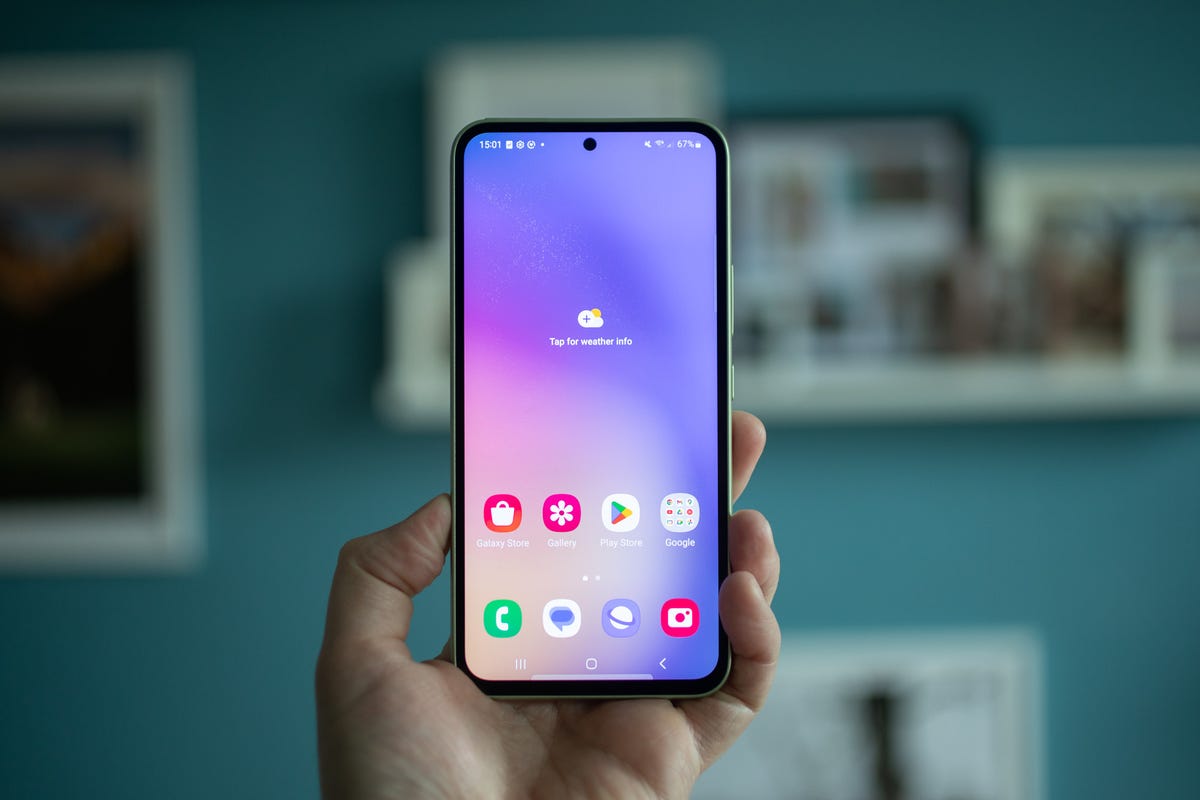
The 6.4-inch display is bright and vibrant.
Galaxy A54 or Pixel 6A?
Even at the Galaxy A54’s competitive price, the competition is fierce, with Google’s superb $349 Pixel 6A and the latest Pixel 7A priced at $499 — just $50 more than the A54’s usual retail price. We gave the Pixel 6A a CNET Editors’ Choice award for its combination of solid all-round performance and affordable price, with it remaining one of the best budget phones money can buy. The new Pixel 7A also impressed us with its great camera and smooth performance, pushing CNET to recommend it over the Pixel 7 since it’s $100 cheaper.
Up against the A54 5G, the Pixel 6A is still the phone to go for. Its performance is a bit better, its camera takes nicer shots and Google’s plain version of Android is generally nicer to use than Samsung’s One UI skin. If you’re willing to pay $50 more, the Pixel 7A also offers better camera performance and wireless charging, which is missing from the Galaxy A54 5G. Still, the A54 is slightly larger and offers microSD card storage expansion, so it’s not a total victory for the Pixel. Here’s what you should know about the phone.
Galaxy A54: Fun design, vibrant display
The lime green version of my A54 5G is really quite pretty with its glossy glass back and metallic-looking edging (that’s actually plastic). It feels nice enough to hold, although it lacks the more solid feel of the Pixel 6A or 7A. It’s IP67 rated for water resistance (as are the Pixel 6A and 7A) which will keep it safe during phone calls in the rain or around clumsy friends carrying beer.
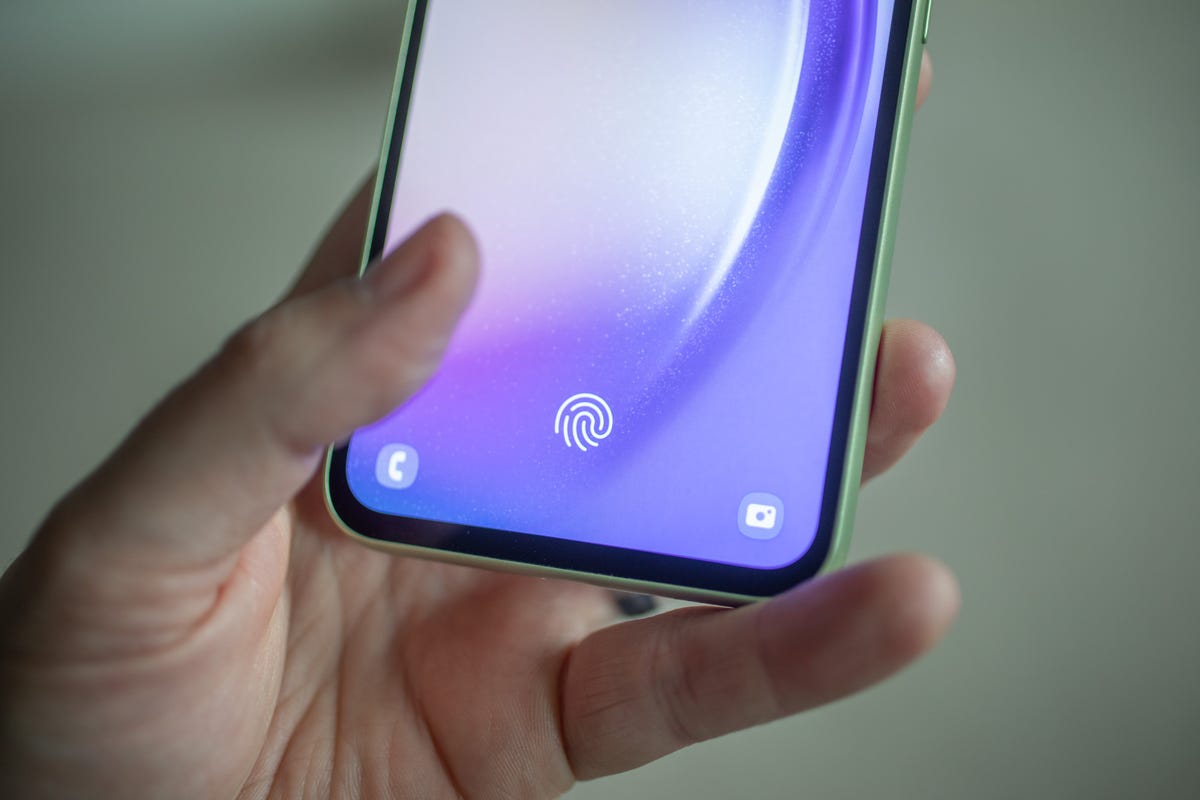
A fingerprint scanner is built into the display.
At 6.4 inches, the display is larger than the Pixel 6A’s 6.1-inch screen, which is worth keeping in mind if you spend a lot of time playing mobile games or watching videos and would benefit from a larger screen. The Galaxy A54’s vibrant screen is quite a bit brighter than the Pixel 6A’s and 7A’s, making it more easily readable outdoors under direct sunshine.
Galaxy A54: Processor, software and battery
The Galaxy A54 runs on an Exynos 1380 processor, backed up by 6GB of RAM. It produced fair scores on benchmark tests considering its low price, coming in a bit below the Pixel 6A. Still, there’s enough power to make everyday web browsing, WhatsApp texting and emailing feel swift. I managed to play both Genshin Impact and Asphalt 9: Legends at default settings with fairly smooth gameplay.
Galaxy A54 vs. Pixel 6A vs. Pixel 7A performance comparison
- Geekbench 6 (single core)
- Geekbench 6 (multi core)
- 3D Mark Wild Life Extreme
It runs on Android 13 at its core, over which Samsung has slapped its One UI software. While I enjoy the overall look of this skin, I don’t like how much clutter Samsung preloads onto the phone. Apps like Disney Plus, Bolt, TikTok and Booking.com came already installed, along with a plethora of Samsung’s own apps (including its own app store, a Galaxy Shop app, SmartThings, Messages and various TV and media apps). There’s also a bunch of preinstalled Microsoft apps like Linkedin and OneNote. I bought the phone unlocked, directly from Samsung in the UK, so you may find different apps on yours — potentially even more carrier-specific apps if you bought it from a network.
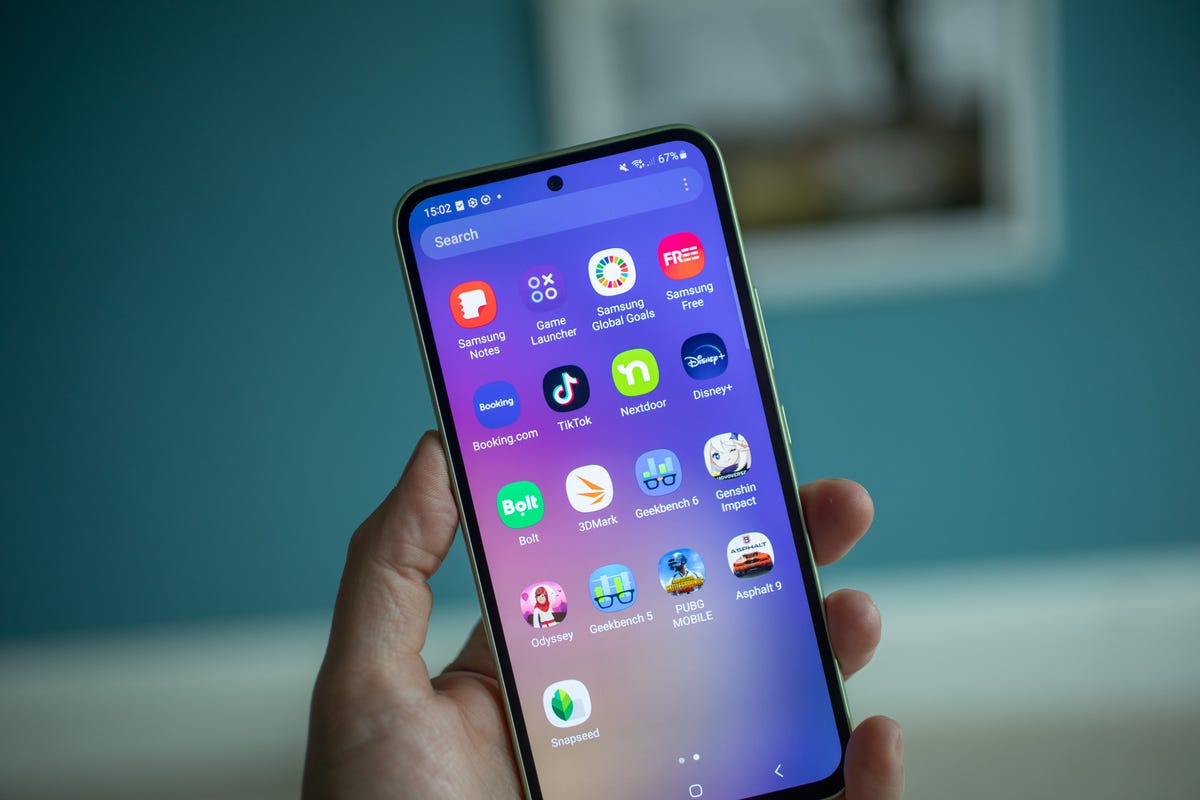
I like the One UI interface, but I don’t like all the preinstalled apps.
While you can uninstall many of these, the extraneous apps make the phone feel messy as soon as you turn it on. By contrast, the Pixel 6A’s default interface is neat, clutter-free and has only the basic Google essentials like Chrome, Gmail and Drive installed as standard, with no third party services forced on you from day one.
Both Samsung and Google promise security updates five years from launch in order to keep them safer to use for longer. However that does mean that the Pixel 6A, having been launched last year, is guaranteed to receive support until 2027, while the A54 should continue to receive updates until 2028. Samsung also offers an additional generation of Android OS updates compared to Google. It’s not a huge difference, but worth keeping in mind if you want to squeeze every ounce of useful life from your device.
The A54 is powered by a 5,000mAh battery which is larger than the 4,410mAh battery in the Pixel 6A. Perhaps due to the larger screen though, battery life was pretty much the same on both phones during my YouTube streaming drain test and in general use throughout the day. With careful use you should get a full day out of either phone, but either phone will still need a full recharge overnight.

It runs Android 13 at its core, with four years of Android generation updates promised by Samsung.
The base Galaxy A54 has 128GB of storage, but it’s one of the last remaining phones to support expandable storage via microSD cards up to 1TB in size. That’s a big tick in its favor as it means you can safely opt for the lowest storage model and simply buy a cheap 128GB card to double the storage, providing loads of room for photos, music or apps.
Galaxy A54: Three cameras for vibrant snaps
On the back of the phone are three cameras; a 50 megapixel main camera, 12 megapixel ultrawide and 5 megapixel macro camera. I found shots from the main camera to be generally decent, although the software optimizations often result in quite oversaturated images which look quite unnatural to my eye. Images look crisp however and the 2x preset digital zoom (there’s no optical zoom here) delivered sharp images.
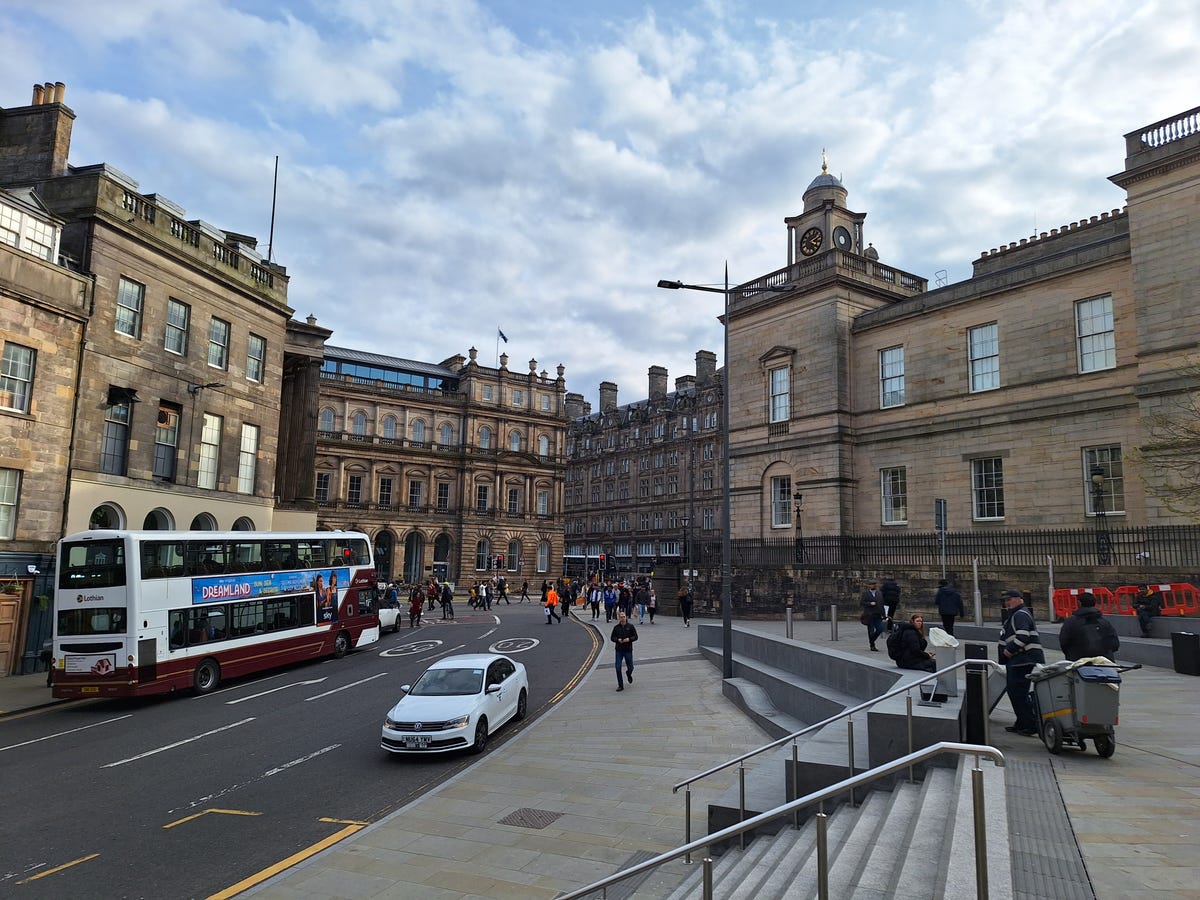
Taken with the main lens, the camera has done a good job of balancing the bright sky and the more shadowy buildings.
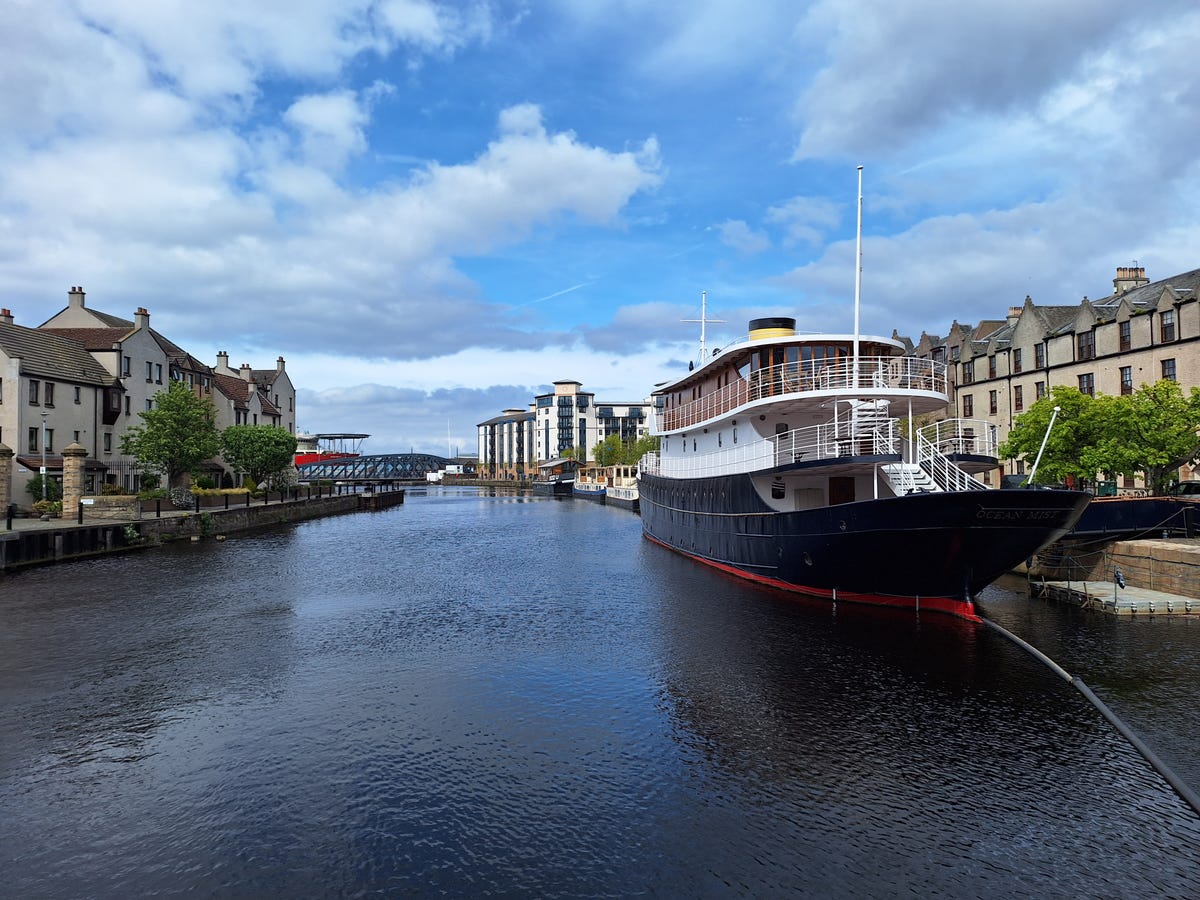
Colors are vibrant here, but a bit cold.
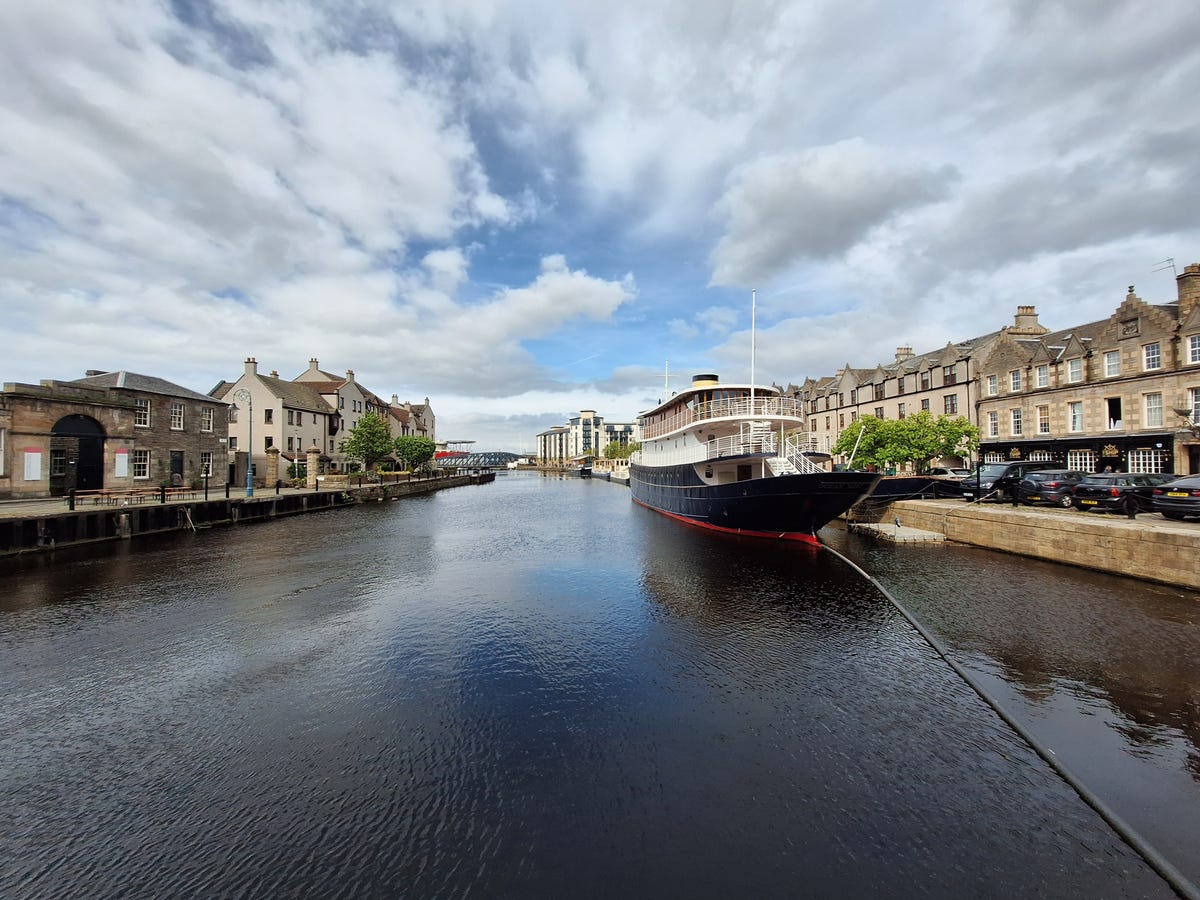
Switching to the ultra-wide lens, the shot looks a lot warmer, which I prefer.
The super wide lens worked well, too, with decent exposures and plenty of detail. I did often find quite a noticeable color shift between the main and wide lenses. The wide lens typically produces slightly warmer colors, which I mostly prefer against the often cool-looking images the main camera captured.
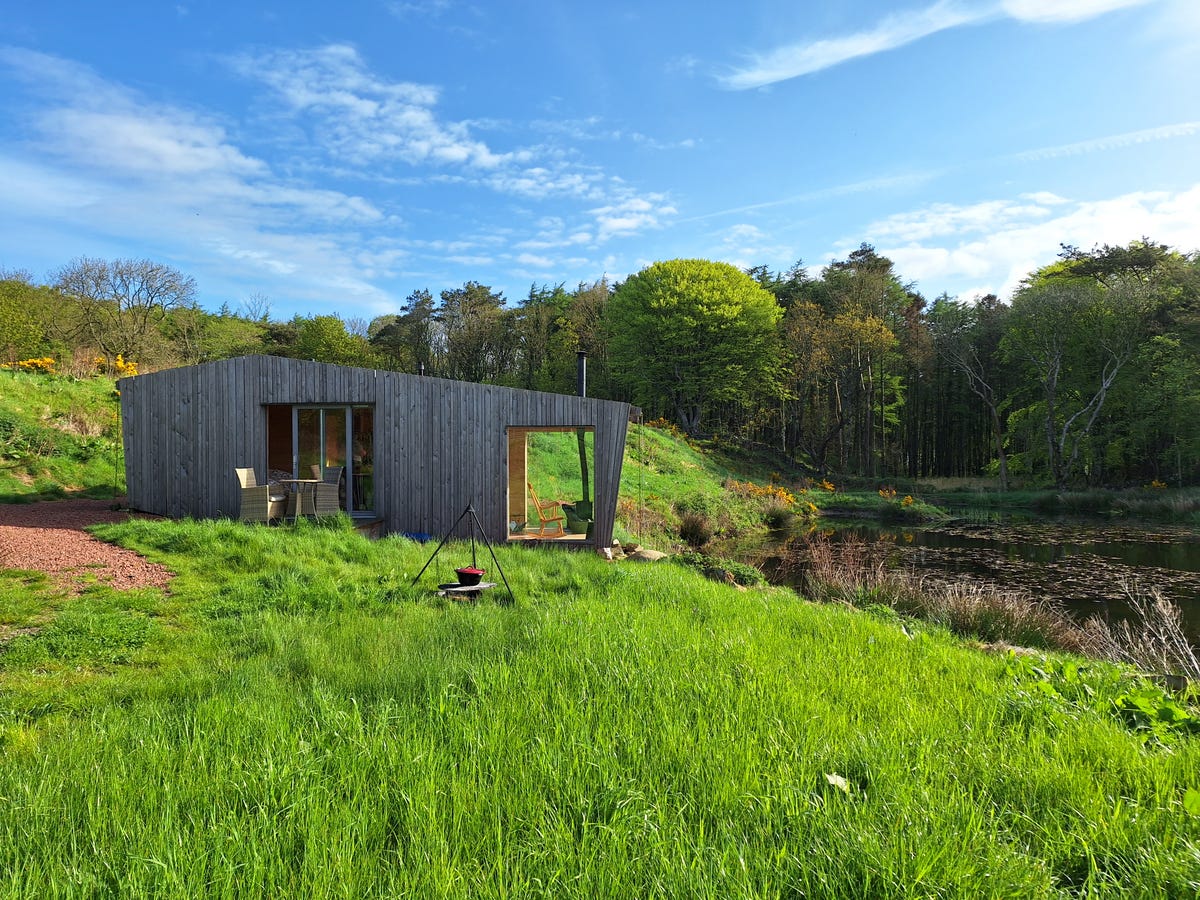
Taken from the A54’s main camera, this outdoor shot is well exposed, but the colours are so over-saturated that they look quite unnatural.

The Pixel 6A’s shot has colors that are much more true-to-life.
Low light images are decent, with the main lens capturing bright, sharp shots that are roughly on par with what we found from the Pixel 6A.
The 5-megapixel macro lens allows you focus close up on your subject. But as with most macro lenses on phones we’ve seen before from OnePlus and Samsung, it’s pretty disappointing. The focus is sometimes off, and colors look more drab compared to photos taken with the main camera. Personally, I’d prefer it had Samsung not tried to squeeze an extra camera in here and simply lopped a little extra off the asking price.
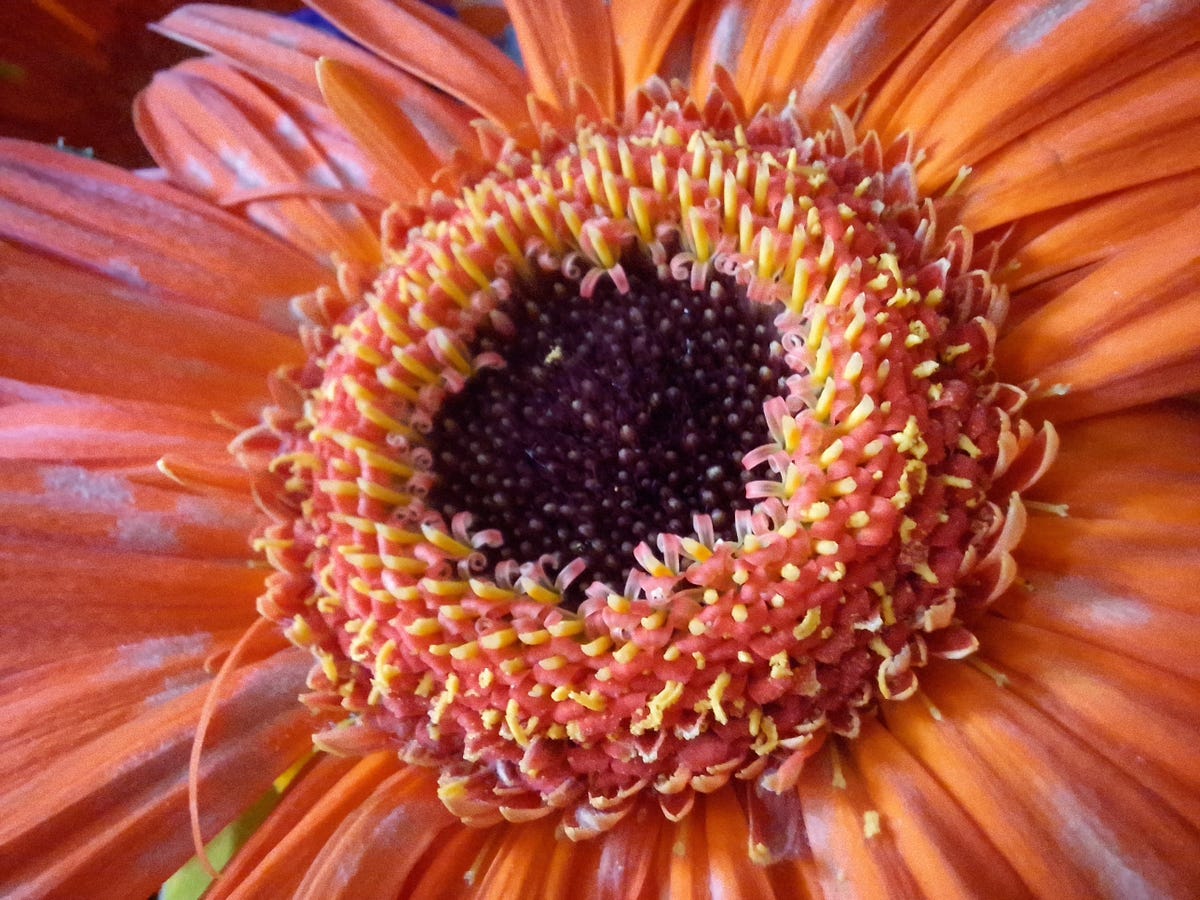
The macro lens lets you get close up on your subject, but the results generally aren’t great and I do find the lens a bit of a pointless addition.

There’s a 32-megapixel selfie camera that does a good job of capturing detailed, well-exposed selfies.
While the A54’s camera setup won’t appeal to photographers among you who want true-to-life images, it’ll do the job well if you just want vibrant shots of your kids on your next beach vacation. But I do prefer shots from both the Pixel 6A and 7A, which produce less over-saturated images with spot-on exposure.
Should you buy the Samsung Galaxy A54 5G?
The A54’s combination of decent performance, fun design, vibrant cameras and low price make it a potentially great budget option. Its bright screen, expandable storage and longer software support are ticks in its favor over Google’s Pixel 6A, but the Pixel 6A wins in almost every other respect. The software is nicer to use, the cameras are better and it’s even cheaper. Between the two, my money would go on the Pixel 6A.
Technologies
Today’s NYT Strands Hints, Answers and Help for Nov. 28 #635
Here are hints and answers for the NYT Strands puzzle for Nov. 28, No. 635.

Looking for the most recent Strands answer? Click here for our daily Strands hints, as well as our daily answers and hints for The New York Times Mini Crossword, Wordle, Connections and Connections: Sports Edition puzzles.
Today’s NYT Strands puzzle is pretty tricky. If you’re not familiar with certain superstitious beliefs, you might not find all the answers. And some of the answers are difficult to unscramble, so if you need hints and answers, read on.
I go into depth about the rules for Strands in this story.
If you’re looking for today’s Wordle, Connections and Mini Crossword answers, you can visit CNET’s NYT puzzle hints page.
Read more: NYT Connections Turns 1: These Are the 5 Toughest Puzzles So Far
Hint for today’s Strands puzzle
Today’s Strands theme is: If all else fails…
If that doesn’t help you, here’s a clue: Don’t tell, it won’t come true.
Clue words to unlock in-game hints
Your goal is to find hidden words that fit the puzzle’s theme. If you’re stuck, find any words you can. Every time you find three words of four letters or more, Strands will reveal one of the theme words. These are the words I used to get those hints but any words of four or more letters that you find will work:
- GLUB, RATS, TARN, DALE, FONT, FOUNT, LASH
Answers for today’s Strands puzzle
These are the answers that tie into the theme. The goal of the puzzle is to find them all, including the spangram, a theme word that reaches from one side of the puzzle to the other. When you have all of them (I originally thought there were always eight but learned that the number can vary), every letter on the board will be used. Here are the nonspangram answers:
- DANDELION, STAR, COIN, FOUNTAIN, LADYBUG, EYELASH
Today’s Strands spangram
Today’s Strands spangram is MAKEAWISH. To find it, start with the M that’s three letters down on the far right, and wind backwards.
Technologies
Today’s NYT Connections Hints, Answers and Help for Nov. 28, #901
Here are some hints and the answers for the NYT Connections puzzle for Nov. 28, #901.
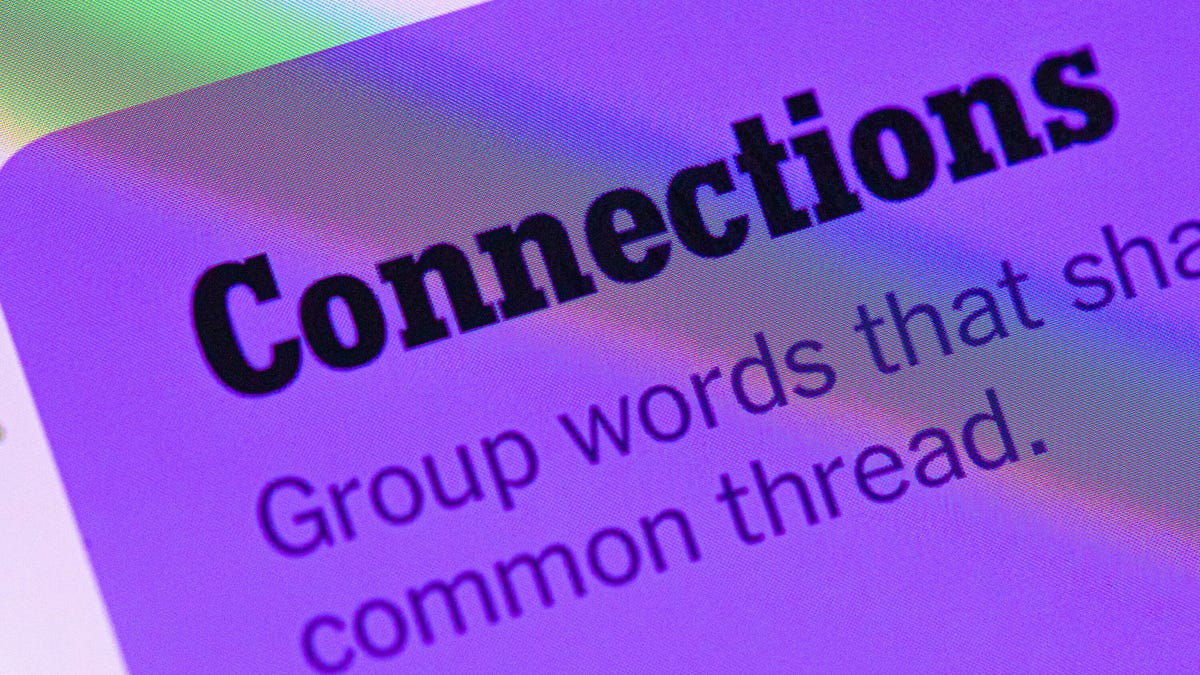
Looking for the most recent Connections answers? Click here for today’s Connections hints, as well as our daily answers and hints for The New York Times Mini Crossword, Wordle, Connections: Sports Edition and Strands puzzles.
Today’s NYT Connections puzzle is kind of tough. If you need help sorting the answers into groups, you’re in the right place. Read on for clues and today’s Connections answers.
The Times now has a Connections Bot, like the one for Wordle. Go there after you play to receive a numeric score and to have the program analyze your answers. Players who are registered with the Times Games section can now nerd out by following their progress, including the number of puzzles completed, win rate, number of times they nabbed a perfect score and their win streak.
Read more: Hints, Tips and Strategies to Help You Win at NYT Connections Every Time
Hints for today’s Connections groups
Here are four hints for the groupings in today’s Connections puzzle, ranked from the easiest yellow group to the tough (and sometimes bizarre) purple group.
Yellow group hint: Appropriate.
Green group hint: I win!
Blue group hint: Musical instrument.
Purple group hint: Time to talk.
Answers for today’s Connections groups
Yellow group: Fitting.
Green group: Achieve victory over.
Blue group: Parts of an electric guitar.
Purple group: Phonetic elements of speech.
Read more: Wordle Cheat Sheet: Here Are the Most Popular Letters Used in English Words
What are today’s Connections answers?
The yellow words in today’s Connections
The theme is fitting. The four answers are fair, just, proper and right.
The green words in today’s Connections
The theme is achieve victory over. The four answers are beat, best, take and worst.
The blue words in today’s Connections
The theme is parts of an electric guitar. The four answers are fret, peg, pickup and string.
The purple words in today’s Connections
The theme is phonetic elements of speech. The four answers are intonation, loudness, rhythm and stress.
Technologies
Anker’s New MagSafe Car Mount Keeps Your Phone Cool While Charging, and It’s 30% Off for Black Friday
Get wired-like charging speeds and MagSafe compatibility with Anker’s wireless car charging bundle for $62.99.
Black Friday is the best time of the year to upgrade the little essentials that make your everyday tech life more pleasant. I’ve found the perfect deal to amp up the phone charging setup in your car. This Anker MagSafe wireless car charging bundle is 30% off for the holidays, and it gives your iPhone a fast and steady way to power up while you navigate. It delivers up to 25-watt wireless charging speeds and with onboard active cooling, your phone stays comfortable to the touch.
Get it now for $62.99 verses the list price of $89.99.
What sets this charger apart is that its performance and cooling tech is built into a surprisingly compact package. The stand uses an ultra-strong Qi2 magnetic lock to keep your phone secure through bumps and turns. You can even tilt the mount and switch between portrait and landscape modes for navigation without blocking the view. The bundle has everything you need to get started including a 60-watt dual-USB-C charger, an adequately long USB-C cable, and cable organizers for a clean setup. Anker also includes a two-year warranty for peace of mind.
If you are getting your car prepped up for driving to a holiday vacation or just need a faster charging mount for your daily commute, this deal makes a lot of sense. CNET’s experts are also tracking more Black Friday and Cyber Monday picks across Apple products, headphones, and more, so you can score more savings before the sales season wraps up.
MOBILE DEALS OF THE WEEK
-
$749 (save $250)
-
$475 (save $175)
-
$499 (save $300)
-
$900 (save $400)
Why this deal matters
A high quality charger is a great addition to any car to speedily top up your phone on the go. You will especially want to look out for options from a top-tier brand like Anker for its fast charging speeds and reliability. This Black Friday deal is an excellent opportunity to save big on a staple car accessory. With holiday shopping heating up and tech accessories being one of the most popular categories, we expect the deal to sell out quick. So don’t wait too long before jumping on it.
Don’t miss any of our unbiased tech content and lab-based reviews. Add CNET as a preferred Google source.
Join Our Daily Deals Text Group!
Get hand-picked deals from CNET shopping experts straight to your phone.
By signing up, you confirm you are 16+ and agree to receive recurring marketing messages at the phone number provided. Consent is not a condition of purchase. Reply STOP to unsubscribe. Msg & data rates may apply. View our Privacy Policy and Terms of Use.
-

 Technologies3 года ago
Technologies3 года agoTech Companies Need to Be Held Accountable for Security, Experts Say
-

 Technologies3 года ago
Technologies3 года agoBest Handheld Game Console in 2023
-

 Technologies3 года ago
Technologies3 года agoTighten Up Your VR Game With the Best Head Straps for Quest 2
-

 Technologies4 года ago
Technologies4 года agoBlack Friday 2021: The best deals on TVs, headphones, kitchenware, and more
-

 Technologies4 года ago
Technologies4 года agoVerum, Wickr and Threema: next generation secured messengers
-

 Technologies4 года ago
Technologies4 года agoGoogle to require vaccinations as Silicon Valley rethinks return-to-office policies
-

 Technologies4 года ago
Technologies4 года agoOlivia Harlan Dekker for Verum Messenger
-

 Technologies4 года ago
Technologies4 года agoiPhone 13 event: How to watch Apple’s big announcement tomorrow
